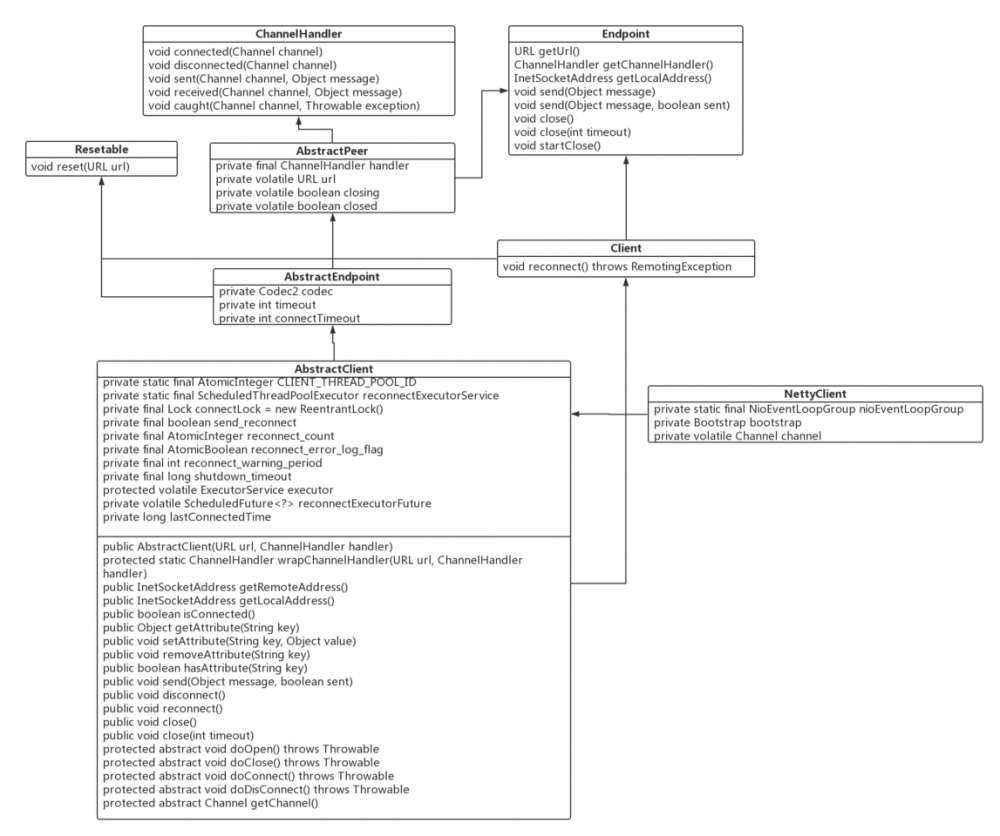源码分析Dubbo网络通信篇NettyClient
在源码分析 Dubbo 通讯篇之网络核心类一文中已给出 Dubbo netty client 的启动流程,如下图:

以 Dubbo 协议为例,DubboProtocol#refer 中,在创建 Invoker 时,通过 getClient 方法,开始 Client(连接的)创建过程,先重点看一下:
private ExchangeClient[] getClients(URL url) { // @1
// whether to share connection
boolean service_share_connect = false;
int connections = url.getParameter(Constants.CONNECTIONS_KEY, 0); // @2
// if not configured, connection is shared, otherwise, one connection for one service
if (connections == 0) {
service_share_connect = true;
connections = 1;
}
ExchangeClient[] clients = new ExchangeClient[connections]; // @3
for (int i = 0; i < clients.length; i++) {
if (service_share_connect) {
clients[i] = getSharedClient(url); // @4
} else {
clients[i] = initClient(url); // @5
}
}
return clients;
}
复制代码
代码@1:参数 URL ,服务提供者 URL。
代码@2:获取 <dubbo:reference connections = "" />,默认0表示客户端对同一个服务提供者的所有服务,使用共享一个连接,如果该值有设置,则使用非共享的客户端,所谓的共享客户端,以 Netty 为例,也即客户端对同一服务提供者发起的不同服务,使用同一个客户端 ( NettyClient)进行请求的发送与接收。
代码@3,根据 connections,创建 ExchangeClients 数组。
代码@4:如果使用共享连接,则调用 getSharedClient 获取共享连接,如果客户端未建立,则创建客户端。
代码@5,如果不使用共享连接,调用 initClient 创建客户端,其创建时序图如上图所示。 接下来,还是以 Netty4 为例,探究一下 Dubbo NettyClient 的创建细节。

1、NettyClient类图
首先从全貌上大概看一下 NettyClient 对象所持有的属性:
- AbstractPeer
- private final ChannelHandler handler : 事件处理Handler。
- private volatile URL url :该协议的第一个服务提供者的URL,Server只需要用到URL中的参数,与具体某一个服务没什么关系。
- AbstractEndpoint
- private Codec2 codec :编码解码器。
- private int timeout : 超时时间
- private int connectTimeout :连接超时时间 注,如果通过dubbo:provider改变codec,不同的服务提供者引用的默认服务提供者参数不同,那这个只能是以第一个为主了,应该不科学?
- AbstractClient
- protected static final String CLIENT_THREAD_POOL_NAME = "DubboClientHandler" Dubbo 客户端线程名称。 private static final AtomicInteger CLIENT_THREAD_POOL_ID = new AtomicInteger() 客户端线程池ID自增器。
- private static final ScheduledThreadPoolExecutor reconnectExecutorService 客户端连接重连线程池。
- private final Lock connectLock = new ReentrantLock() 客户端连接服务端独占锁,保证一个客户端同时只会一个线程在执行连接动作。
- private final boolean send_reconnect 消息发送时,如果当前客户端未连接,是否发起重连操作。
- private final AtomicInteger reconnect_count = new AtomicInteger(0) 记录重连的次数。
- private final AtomicBoolean reconnect_error_log_flag = new AtomicBoolean(false) 连接出错后是否打印过ERROR日志。
- private final int reconnect_warning_period :对连接异常,以WARN级别日志输出的频率,默认第一次是以Error日志,然后每出现reconnect_warning_period次后,就打印一次warn级别日志。
- private final long shutdown_timeout :关闭服务的超时时间。
- protected volatile ExecutorService executor 客户端线程池。
- private volatile ScheduledFuture< ?> reconnectExecutorFuture = null 重连的Future。
- 11、private long lastConnectedTime = System.currentTimeMillis() 上一次重连时间戳。
- NettyClient
- private static final NioEventLoopGroup nioEventLoopGroup = new NioEventLoopGroup(Constants.DEFAULT_IO_THREADS, new DefaultThreadFactory("NettyClientWorker", true)); IO线程组,同一个JVM中所有的客户端公用一个IO线程组,且线程数固定为(32与CPU核数+1的最小值)。
- private Bootstrap bootstrap :Netty客户端启动实例。
- private volatile Channel channel:客户端连接,请copy其引用使用。
2、源码分析NettyClient
2.1 源码分析构造函数
public NettyClient(final URL url, final ChannelHandler handler) throws RemotingException { // @1
super(url, wrapChannelHandler(url, handler)); // @2
}
复制代码
代码@1:url:服务提供者URL;ChannelHandler handler:事件处理器。
代码@2:wrapChannelHandler在讲解NettyServer时已重点分析,构造其事件转发模型(Dispatch)。
接下来重点分析其父类的构造方法:
public AbstractClient(URL url, ChannelHandler handler) throws RemotingException {
super(url, handler); // @1
send_reconnect = url.getParameter(Constants.SEND_RECONNECT_KEY, false);
shutdown_timeout = url.getParameter(Constants.SHUTDOWN_TIMEOUT_KEY, Constants.DEFAULT_SHUTDOWN_TIMEOUT);
// The default reconnection interval is 2s, 1800 means warning interval is 1 hour.
reconnect_warning_period = url.getParameter("reconnect.waring.period", 1800); // @2
try {
doOpen(); // @3
} catch (Throwable t) {
close();
throw new RemotingException(url.toInetSocketAddress(), null,
"Failed to start " + getClass().getSimpleName() + " " + NetUtils.getLocalAddress()
+ " connect to the server " + getRemoteAddress() + ", cause: " + t.getMessage(), t);
}
try {
// connect.
connect(); // @4
if (logger.isInfoEnabled()) {
logger.info("Start " + getClass().getSimpleName() + " " + NetUtils.getLocalAddress() + " connect to the server " + getRemoteAddress());
}
} catch (RemotingException t) {
if (url.getParameter(Constants.CHECK_KEY, true)) {
close();
throw t;
} else {
logger.warn("Failed to start " + getClass().getSimpleName() + " " + NetUtils.getLocalAddress()
+ " connect to the server " + getRemoteAddress() + " (check == false, ignore and retry later!), cause: " + t.getMessage(), t);
}
} catch (Throwable t) {
close();
throw new RemotingException(url.toInetSocketAddress(), null,
"Failed to start " + getClass().getSimpleName() + " " + NetUtils.getLocalAddress()
+ " connect to the server " + getRemoteAddress() + ", cause: " + t.getMessage(), t);
}
executor = (ExecutorService) ExtensionLoader.getExtensionLoader(DataStore.class) // @5
.getDefaultExtension().get(Constants.CONSUMER_SIDE, Integer.toString(url.getPort()));
ExtensionLoader.getExtensionLoader(DataStore.class)
.getDefaultExtension().remove(Constants.CONSUMER_SIDE, Integer.toString(url.getPort()));
}
复制代码
代码@1:调用父类的构造其,初始化url、ChannelHandler。 代码@2:初始化send_reconnect 、shutdown_timeout、reconnect_warning_period(默认1小时打印一次日志) 代码@3:调用doOpen初始化客户端调用模型,后续重点分析。 代码@4:调用connect方法,向服务端发起TCP连接。 代码@5:获取线程池,并从缓存中移除。 1.2 doOpen
protected void doOpen() throws Throwable {
NettyHelper.setNettyLoggerFactory();
final NettyClientHandler nettyClientHandler = new NettyClientHandler(getUrl(), this); // @1
bootstrap = new Bootstrap(); // @2
bootstrap.group(nioEventLoopGroup) // @3
.option(ChannelOption.SO_KEEPALIVE, true)
.option(ChannelOption.TCP_NODELAY, true)
.option(ChannelOption.ALLOCATOR, PooledByteBufAllocator.DEFAULT)
//.option(ChannelOption.CONNECT_TIMEOUT_MILLIS, getTimeout())
.channel(NioSocketChannel.class);
if (getTimeout() < 3000) { // @4
bootstrap.option(ChannelOption.CONNECT_TIMEOUT_MILLIS, 3000);
} else {
bootstrap.option(ChannelOption.CONNECT_TIMEOUT_MILLIS, getTimeout());
}
bootstrap.handler(new ChannelInitializer() {
@Override
protected void initChannel(Channel ch) throws Exception {
NettyCodecAdapter adapter = new NettyCodecAdapter(getCodec(), getUrl(), NettyClient.this);
ch.pipeline()//.addLast("logging",new LoggingHandler(LogLevel.INFO))//for debug
.addLast("decoder", adapter.getDecoder())
.addLast("encoder", adapter.getEncoder())
.addLast("handler", nettyClientHandler); // @5
}
});
}
复制代码
代码@1:创建 NettyClientHandler。
代码@2:创建 Netty 客户端启动实例 bootstrap.
代码@3:客户端绑定IO线程组(池),注意,一个 JVM 中所有的 NettyClient 共享其 IO 线程。
代码@4:设置连接超时时间,最小连接超时时间为3s。
代码@5:设置编码器、事件连接器,当触发事件后,将调用nettyClientHandler中相关的方法。
2.3 doConnect
protected void doConnect() throws Throwable {
long start = System.currentTimeMillis();
ChannelFuture future = bootstrap.connect(getConnectAddress()); // @1
try {
boolean ret = future.awaitUninterruptibly(3000, TimeUnit.MILLISECONDS); // @2
if (ret && future.isSuccess()) {
Channel newChannel = future.channel();
try {
// Close old channel
Channel oldChannel = NettyClient.this.channel; // copy reference
if (oldChannel != null) {
try {
if (logger.isInfoEnabled()) {
logger.info("Close old netty channel " + oldChannel + " on create new netty channel " + newChannel);
}
oldChannel.close();
} finally {
NettyChannel.removeChannelIfDisconnected(oldChannel);
}
}
} finally {
if (NettyClient.this.isClosed()) {
try {
if (logger.isInfoEnabled()) {
logger.info("Close new netty channel " + newChannel + ", because the client closed.");
}
newChannel.close();
} finally {
NettyClient.this.channel = null;
NettyChannel.removeChannelIfDisconnected(newChannel);
}
} else {
NettyClient.this.channel = newChannel;
}
}
} else if (future.cause() != null) {
throw new RemotingException(this, "client(url: " + getUrl() + ") failed to connect to server "
+ getRemoteAddress() + ", error message is:" + future.cause().getMessage(), future.cause());
} else {
throw new RemotingException(this, "client(url: " + getUrl() + ") failed to connect to server "
+ getRemoteAddress() + " client-side timeout "
+ getConnectTimeout() + "ms (elapsed: " + (System.currentTimeMillis() - start) + "ms) from netty client "
+ NetUtils.getLocalHost() + " using dubbo version " + Version.getVersion());
}
} finally {
if (!isConnected()) {
//future.cancel(true);
}
}
}
复制代码
代码@1:调用bootstrap.connect方法发起TCP连接。
代码@2:future.awaitUninterruptibly,连接事件只等待3S,这里写成固定了,显然没有与doOpen方法中ChannelOption.CONNECT_TIMEOUT_MILLIS保持一致。
关于 NettyClient 的介绍就将到这里了,下一篇将会分析编码解码。
作者介绍:丁威,《RocketMQ技术内幕》作者,RocketMQ 社区优秀布道师、CSDN2019博客之星TOP10,维护公众号: 中间件兴趣圈 目前已陆续发表源码分析Java集合、Java 并发包(JUC)、Netty、Mycat、Dubbo、RocketMQ、Mybatis等源码专栏。可以点击链接加入 中间件知识星球 ,一起探讨高并发、分布式服务架构,交流源码。

- 本文标签: 源码 线程 时间 锁 src Atom Java集合 dubbo:provider 2019 协议 tar 代码 volatile client message MQ bug 并发 java SDN 参数 Connection 线程池 IO 模型 类图 https Netty mybatis ThreadPoolExecutor Logging NIO 高并发 retry ip Bootstrap key consumer IOS executor RocketMQ 缓存 db IDE 实例 provider 博客 constant 分布式 构造方法 node UI CTO dubbo http Service id remote cat TCP final DDL 处理器 服务端 JVM
- 版权声明: 本文为互联网转载文章,出处已在文章中说明(部分除外)。如果侵权,请联系本站长删除,谢谢。
- 本文海报: 生成海报一 生成海报二











![[HBLOG]公众号](http://www.liuhaihua.cn/img/qrcode_gzh.jpg)

